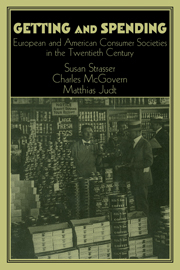Book contents
- Frontmatter
- Introduction
- Part One Politics, Markets, and the State
- Part Two Everyday Life
- 9 World War I and the Creation of Desire for Automobiles in Germany
- 10 Gender, Generation, and Consumption in the United States: Working-Class Families in the Interwar Period
- 11 Comparing Apples and Oranges: Housewives and the Politics of Consumption in Interwar Germany
- 12 “The Convenience Is Out of This World”: The Garbage Disposer and American Consumer Culture
- 13 Consumer Culture in the GDR, or How the Struggle for Antimodernity Was Lost on the Battleground of Consumer Culture
- 14 Changes in Consumption as Social Practice in West Germany During the 1950s
- 15 Reshaping Shopping Environments: The Competition Between the City of Boston and Its Suburbs
- 16 Toys, Socialization, and the Commodification of Play
- 17 The “Syndrome of the 1950s” in Switzerland: Cheap Energy, Mass Consumption, and the Environment
- 18 Reflecting on Ethnic Imagery in the Landscape of Commerce, 1945-1975
- Part Three History and Theory
- Index
15 - Reshaping Shopping Environments: The Competition Between the City of Boston and Its Suburbs
Published online by Cambridge University Press: 05 January 2013
- Frontmatter
- Introduction
- Part One Politics, Markets, and the State
- Part Two Everyday Life
- 9 World War I and the Creation of Desire for Automobiles in Germany
- 10 Gender, Generation, and Consumption in the United States: Working-Class Families in the Interwar Period
- 11 Comparing Apples and Oranges: Housewives and the Politics of Consumption in Interwar Germany
- 12 “The Convenience Is Out of This World”: The Garbage Disposer and American Consumer Culture
- 13 Consumer Culture in the GDR, or How the Struggle for Antimodernity Was Lost on the Battleground of Consumer Culture
- 14 Changes in Consumption as Social Practice in West Germany During the 1950s
- 15 Reshaping Shopping Environments: The Competition Between the City of Boston and Its Suburbs
- 16 Toys, Socialization, and the Commodification of Play
- 17 The “Syndrome of the 1950s” in Switzerland: Cheap Energy, Mass Consumption, and the Environment
- 18 Reflecting on Ethnic Imagery in the Landscape of Commerce, 1945-1975
- Part Three History and Theory
- Index
Summary
introduction
The German notion “Stadtluft macht frei” refers, above all, to the rights of citizenship that townspeople in Germany and other European countries enjoyed during the Middle Ages. Once you had resided in a city or town for a year and a day, you were free of any obligation of servitude; in short, the peasant became a burgher. Yet, in a broader sense, this notion also refers to the cultural and economic opportunities that medieval towns offered. It is no wonder that urbanized areas often located near the sea or on important rivers became centers of economic progress. The development of trade and commerce made towns in Europe distinct from rural areas. Eventually, the process of industrialization in the nineteenth and early twentieth centuries allowed urban centers in Europe and North America to become regional economic powerhouses. In addition, the development of suburban areas displaced farmland to regions farther away from the center and absorbed the population surplus from the burgeoning cities.
Today, the role of cities in the industrialized world has changed profoundly. In contrast to those in previous periods of history, contemporary European and American cities show signs of decline, with the decay of spaces previously used for industrial and commercial purposes. Cities and towns seem to have lost their edge - to the benefit of their surrounding areas. The suburbs not only benefit from the out-migration of upwardly mobile people but also offer business opportunities to industrial and commercial enterprises that formerly looked for locations within the cities themselves.
- Type
- Chapter
- Information
- Getting and SpendingEuropean and American Consumer Societies in the Twentieth Century, pp. 317 - 338Publisher: Cambridge University PressPrint publication year: 1998



